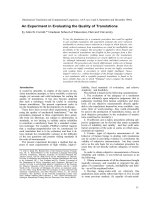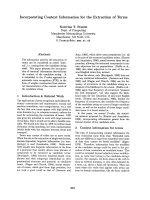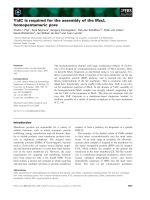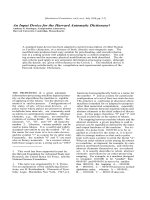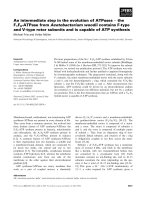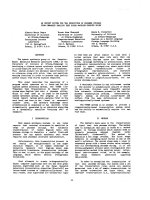Báo cáo toán học: "An Asymptotic Expansion for the Number of Permutations with a Certain Number of Inversions" docx
Bạn đang xem bản rút gọn của tài liệu. Xem và tải ngay bản đầy đủ của tài liệu tại đây (127.92 KB, 11 trang )
An Asymptotic Expansion for the Number of
Permutations with a Certain Number of Inversions
Lane Clark
Department of Mathematics
Southern Illinois University Carbondale
Carbondale, IL 62901-4408 USA
Submitted: December 17, 1998; Accepted: August 8, 2000
Abstract
Let b(n, k) denote the number of permutations of {1, ,n} with precisely k
inversions. We represent b(n, k) as a real trigonometric integral and then use the
method of Laplace to give a complete asymptotic expansion of the integral. Among
the consequences, we have a complete asymptotic expansion for b(n, k)/n!fora
range of k including the maximum of the b(n, k)/n!.
AMS Subject Classification: 05A16, 05A15, 05A10
A permutation σ =(σ(1), ,σ(n)) of [n]={1, ,n} has an inversion at (i, j),
where 1 ≤ i<j≤ n, if and only if σ(i) >σ(j). Let b(n, k) denote the number of
permutations of [n] with precisely k inversions. Then b(n, k)=b(n,
n
2
− k) for all
integers k, while, b(n, k) =0ifandonlyif0≤ k ≤
n
2
. Bender [2; p. 110] showed
that the b(n, k) are log concave in k. Hence, the maximum B(n)oftheb(n, k) occurs at
k =
n
2
/2,aswellas
n
2
/2 for odd
n
2
. See [3; pps. 236–240] for further results.
Random permutations show (see [3; pps. 282–283], for example) that the b(n, k)
satisfy a central limit theorem with µ
n
=
n
2
/2andσ
2
n
= n(n − 1)(2n +5)/72 (see [2;
Theorem 1]). Bender [2; p. 109] remarks that “the theorems of Section 4 do not apply”
to the b(n, k). He then shows [2; p. 110] that the b(n, k) are log concave in k “so that
Lemma 2 applies.” This will give a (first term) asymptotic formula for b(n, k)/n!when
k = µ
n
+ xσ
n
where x is a fixed real number.
In this paper, we represent b(n, k) as a real trigonometric integral. We then use the
method of Laplace to give a complete asymptotic expansion of this integral in terms of the
Bernoulli numbers and Hermite polynomials. Hence, we have the complete asymptotic
1
the electronic journal of combinatorics 7 (2000), #R50 2
expansion
b(n, k)
n!
=6(2π)
−1/2
n
−3/2
e
−x
2
/2
1+
2m−2
q=1
(−2)
−q
S
2q
(n)H
2q
(2
−1/2
x)
+ O
ln
2m
2
+1
n
n
m+3/2
as n →∞, (1)
when 2k =
n
2
± xn
3/2
/3wherex
2
= x
2
(n) ≤ ln n and m is a fixed integer at least 2.
Here, H
2q
are the Hermite polynomials defined before Theorem 1 and the S
2q
are defined
in Theorem 3. In particular, we have a complete asymptotic expansion for B(n)/n!when
n
2
is even. See Corollaries 2, 4 for other asymptotic expansions.
In what follows, k, and n are integers with 0 ≤ k ≤
n
2
and 2 ≤ ≤ n. We denote
the nonnegative integers by N. All asymptotic formulas are for n →∞.
Muir [5] (see also [3; p. 239]) showed that b(n, k) is the coefficient of z
k
in
n
=2
(1 +
z + ···+ z
−1
). Then,
b(n, k)=
1
2πi
C
n
=2
(1 + z + ···+ z
−1
)
z
k+1
dz
=
1
2πi
C
z
−k−1
n
=2
z
− 1
z − 1
dz,
where C is the unit circle. Hence,
b(n, k)=
2n!
π
π/2
0
n
=2
sin t
sin t
cos
n
2
− 2k
t
dt, (2)
upon parameterizing C (z =e
it
; t ∈ [0, 2π]) and using the symmetry of the integrand.
For an integer n ≥ 2 and real numbers a, b and x,let
I(n, x, a, b):=
b
a
n
=2
sin t
sin t
cos
xtn
3/2
3
dt
and
I(n, x):=I
n, x, 0,
π
2
(where all discontinuities of the integrand have been removed). Then (2) gives
b(n, k)
n!
=
2
π
I(n, x), (3)
for all integers k,n where 0 ≤ k ≤
n
2
, n ≥ 2and2k =
n
2
± xn
3/2
/3.
the electronic journal of combinatorics 7 (2000), #R50 3
For a nonnegative integer q and real number x,let
F
q
(x):=
∞
0
exp(−u
2
/2)u
q
cos(ux) du
denote the Fourier cosine transform of exp(−u
2
/2)u
q
.ThenF
2q
(x)=
(−1)
q
π
1/2
2
−q−1/2
e
−x
2
/2
H
2q
(2
−1/2
x). Here H
n
(x) are the Hermite polynomials given by
H
n
(x)=
n/2
k=0
(−1)
k
n!(2x)
n−2k
k!(n − 2k)! (see [4; pps. 60-64]).
We use the following Taylor series approximations which are valid for all real
numbers t.
sin t = t −
t
3
6
+ a(t); |a(t)|≤
t
4
24
for all real t and a(t) ≥ 0fort ∈ [0,π]; (4)
cos t =1−
t
2
2
+ b(t); 0 ≤ b(t) ≤ t
3
for t ∈ [0,π]; (5)
and for an integer m ≥ 1,
e
t
=1+t + ···+
t
m−1
(m − 1)!
+ c
m
(t); |c
m
(t)|≤e
|t|
|t|
m
. (6)
Of course, our error terms a, b and c
m
are all infinitely-differentiable functions over the
reals. We also require the following inequality (integration by parts). For a real number
x>0,
∞
x
e
−t
2
/2
dt ≤
1
x
e
−x
2
/2
. (7)
We now give our first result.
Theorem 1. For x
2
= x
2
(n) ≤ ln n, we have the asymptotic expansion
I(n, x)=3
π
2
1/2
n
−3/2
e
−x
2
/2
1 −
1
100n
(9x
4
− 129x
2
+ 102)
+
1
980000n
2
3969x
8
− 141282x
6
+ 1340865x
4
− 4579480x
2
+ 2259370
+ O
ln
19
n
n
9/2
as n →∞.
Proof. We use the method of Laplace. For 0 <a≤ 1 and an integer ≥ 2, let
M
(a):=max{| sin t/ sin t| : t ∈ [a, π/2]} and b := cos a ∈ (0, 1). For all integers ≥ 2,
M
(a) ≤ b
−1
+b
−2
+···+b+1 ≤ min{, (1−b)
−1
} by induction on , while a
2
/3 ≤ 1−b.
Here,
n
=2
sin t
sin t
≤
(1 − b)
−n
n!
≤
3e
a
2
n
n
,
the electronic journal of combinatorics 7 (2000), #R50 4
and, hence, for all n ≥ 9andallrealnumbersx,
|I(n, x, 3n
−0.5
,π/2)|≤2
e
3
n
. (8)
For all integers and all real numbers t with sin t = 0, (4) gives sin t/ sin t =
1 − (
2
− 1)t
2
/6+d(, t)where|d(, t)|≤
3
t
3
/12 for t ∈ (0, 1] and ≥ 2. Hence,
0 <
sin t
sin t
≤ 1 −
2
t
2
24
≤ exp
−
2
t
2
24
for t ∈ [0, 1] and ≥ 2. (9)
(Naturally, we define sin t/ sin t =1whent = 0 to remove that discontinuity.) For all
n ≥ 144 and all real numbers x, (9) gives
|I(n, x, n
−0.7
, 3n
−0.5
)|≤
3n
−0.5
n
−0.7
n
0.5
/3
=2
sin t
sin t
dt ≤ exp
−n
0.1
4608
, (10)
|I(n, x, n
−1
,n
−0.7
)|≤
n
−0.7
n
−1
n
0.7
=2
sin t
sin t
dt ≤ exp
−n
0.1
576
, (11)
and
|I(n, x, n
−3/2
ln n, n
−1
)|≤
n
−1
n
−3/2
ln n
n
=2
sin t
sin t
dt ≤ exp
−
ln
2
n
72
. (12)
Recall that cot t = t
−1
+
∞
k=1
(−4)
k
B
2k
t
2k−1
/(2k)!, for real t with 0 < |t| <π.Here
B
n
are the Bernoulli numbers defined by z/(e
z
− 1) =
∞
n=0
B
n
z
n
/n! for complex z
with |z| < 2π (see [3; pps. 48, 88]). Then,
d
dt
ln(sin t/ sin t)
= cot t − cot t =
∞
k=1
(−4)
k
B
2k
(
2k
− 1)t
2k−1
/(2k)! for 0 < |t| <π, hence,
ln
sin t
sin t
=
∞
k=1
(−4)
k
B
2k
(
2k
− 1)
t
2k
(2k)(2k)!
for |t| <π. (13)
For a nonnegative integer m, |t|≤1and ≥ 1 (see [1; p. 805]),
∞
k=m+1
(−4)
k
B
2k
(
2k
− 1)
t
2k
(2k)(2k)!
≤
2m+2
t
2m+2
. (14)
For n ≥ 2andθ
k
(n):=
n
=2
(
k
− 1) (see [3; p. 155]), (13), (14; m =3)and(6;m =1)
the electronic journal of combinatorics 7 (2000), #R50 5
give
I(n, x, 0,n
−3/2
ln n)
=
n
−3/2
ln n
0
exp
−
n
=2
2
− 1
6
t
2
+
4
− 1
180
t
4
+
6
− 1
2835
t
6
+ O(n
8
t
8
)
cos
xtn
3/2
3
dt
=
n
−3/2
ln n
0
exp
−
θ
2
(n)t
2
6
−
θ
4
(n)t
4
180
−
θ
6
(n)t
6
2835
+ O(n
9
t
8
)
cos
xtn
3/2
3
dt
=
n
−3/2
ln n
0
exp
−
θ
2
(n)t
2
6
−
θ
4
(n)t
4
180
−
θ
6
(n)t
6
2835
cos
xtn
3/2
3
dt + O
ln
9
n
n
9/2
=
3
n
3/2
ln n/3
0
exp
−
u
2
2
exp
R
2
(n)u
2
+ R
4
(n)u
4
+ R
6
(n)u
6
cos(ux) du
+ O
ln
9
n
n
9/2
, (15)
upon setting u = n
3/2
t/3, where R
2
(n)=−3/4n +5/4n
2
, R
4
(n)=−9/100n − 9/40n
2
−
3/20n
3
+93/200n
5
and R
6
(n)=−9/245n
2
− 9/70n
3
− 9/70n
4
+3/70n
6
+ 123/490n
8
.It
is readily seen that the error term in (15) is at most e n
−9/2
ln
9
n for all n ≥ 2 and all
real numbers x. For 0 ≤ u ≤ ln n/3, (6; m =3)gives
exp
R
2
(n)u
2
+ R
4
(n)u
4
+ R
6
(n)u
6
=1+S
2
(n)u
2
+ S
4
(n)u
4
+ S
6
(n)u
6
+ S
8
(n)u
8
+ O
ln
18
n
n
3
, (16)
where S
2
(n)=−3/4n +5/4n
2
, S
4
(n)=−9/100n +9/160n
2
, S
6
(n) = 603/19600n
2
and
S
8
(n)=81/20000n
2
. Hence, (15) and (16) give
I(n, x, 0,n
−3/2
ln n)
=
3
n
3/2
ln n/3
0
exp
−
u
2
2
1+S
2
(n)u
2
+ S
4
(n)u
4
+ S
6
(n)u
6
+ S
8
(n)u
8
+ O
ln
18
n
n
3
cos(ux) du + O
ln
9
n
n
9/2
=
3
n
3/2
ln n/3
0
exp
−
u
2
2
1+S
2
(n)u
2
+ S
4
(n)u
4
+ S
6
(n)u
6
+ S
8
(n)u
8
cos(ux) du
+ O
ln
19
n
n
9/2
=
3
n
3/2
∞
0
exp
−
u
2
2
1+S
2
(n)u
2
+ S
4
(n)u
4
+ S
6
(n)u
6
+ S
8
(n)u
8
cos(ux) du
+ O
∞
ln n/3
exp
−
u
2
4
du
+ O
ln
19
n
n
9/2
the electronic journal of combinatorics 7 (2000), #R50 6
=
3
n
3/2
∞
0
exp
−
u
2
2
1+S
2
(n)u
2
+ S
4
(n)u
4
+ S
6
(n)u
6
+ S
8
(n)u
8
cos(ux) du
+ O
ln
19
n
n
9/2
, (17)
where the last equation follows from (7). The error term in the first equation holds
uniformly for all real numbers x by the comments after (15) and, since | cos(ux)|≤1,
the error term in the second equation holds uniformly for all real numbers x by (16) as
does the error term in the third equation involving the integral. Then (8), (10–12) and
(17) give
I(n, x)=
3
n
3/2
F
0
(x)+S
2
(n)F
2
(x)+S
4
(n)F
4
(x)+S
6
(n)F
6
(x)+S
8
(n)F
8
(x)
+ O
ln
19
n
n
9/2
, (18)
where our error term holds uniformly for all real numbers x. Hence, after simplifying
(18) we obtain
I(n, x)=3
π
2
1/2
n
−3/2
e
−x
2
/2
1 −
1
100n
9x
4
− 129x
2
+ 102
+
1
980000n
2
3969x
8
− 141282x
6
+ 1340865x
4
− 4579480x
2
+ 2259370
+ O
ln
19
n
n
9/2
, (19)
where our error term holds uniformly for all real numbers x. Our result follows since,
apart from the error term, the smallest term in (19) has order of magnitude at least n
−4
for x
2
= x
2
(n) ≤ ln n.
We note several consequences of Theorem 1.
Corollary 2. For x
2
= x
2
(n) ≤ ln n, we have the asymptotic expansion
b(n, k)
n!
=6(2π)
−1/2
n
−3/2
e
−x
2
/2
1 −
1
100n
(9x
4
− 129x
2
+ 102)
+
1
980000n
2
3969x
8
− 141282x
6
+ 1340865x
4
− 4579480x
2
+ 2259370
+ O
ln
19
n
n
9/2
as n →∞,
when 2k =
n
2
± xn
3/2
/3. We also have the asymptotic expansion
b(n, k)
n!
=6(2π)
−1/2
n
−3/2
1 −
51
50n
+
225937
98000n
2
+ o
1
n
7/2
as n →∞,
provided 2k =
n
2
+ o(n
1/2
ln
−3/2
n). In particular, B(n)/n! has the same asymptotic
expansion.
the electronic journal of combinatorics 7 (2000), #R50 7
Proof. The asymptotic expansion for b(n, k)/n!when2k =
n
2
± xn
3/2
/3wherex
2
=
x
2
(n) ≤ ln n follows immediately from (3) and Theorem 1. For all n ≥ e
141
and all real
numbers x, (8) and (10–12) give
π/2
n
−3/2
ln n
n
=2
sin t
sin t
1 − cos
xtn
3/2
3
dt
≤ 10 exp
−
ln
2
n
72
. (20)
For an integer ≥ 2 and all t ∈ [0,π/2], sin t/ sin t ∈ [0, 1] by induction on .
Then, for all n ≥ 2 and all x ∈ [0, ln
−1
n], (5) gives
0 ≤
n
−3/2
ln n
0
n
=2
sin t
sin t
1 − cos
xtn
3/2
3
dt
≤
n
−3/2
ln n
0
x
2
t
2
n
3
18
dt =
x
2
ln
3
n
54n
3/2
. (21)
Hence, for all n ≥ e
141
and all x ∈ [0, ln
−1
n], (20) and (21) give
I(n, 0) − I(n, x)
≤
x
2
ln
3
n
54n
3/2
+10exp
−
ln
2
n
72
. (22)
Assume
n
2
is even (odd
n
2
is similar) and n ≥ e
141
.Let :=
n
2
/2+n
3/2
/6lnn
so that 2 =
n
2
+ xn
3/2
/3withx ∈ [0, ln
−1
n]. For
n
2
≤ 2k ≤ 2, log concavity of the
b(n, k) implies
b
n,
n
2
2
≥ b(n, k) ≥ b(n, ),
so that (3) and (22) give
2
π
I(n, 0) ≥
b(n, k)
n!
≥
2
π
I(n, 0) −
x
2
ln
3
n
27πn
3/2
−
20
π
exp
−
ln
2
n
72
.
Hence, Theorem 1 gives
b(n, k)
n!
=6(2π)
−1/2
n
−3/2
1 −
51
50n
+
225937
98000n
2
+ o
1
n
7/2
,
for 2k =
n
2
+ o
n
1/2
ln
−3/2
n
.
Remark. We can replace the o(n
−7/2
) error term in the asymptotic expansion of
B(n)/n!withO(n
−9/2
ln
19
n).
The following extension of Theorem 1 (the case m = 3) giving a complete asymptotic
expansion of I(n, x) can be immediately read out of its proof.
the electronic journal of combinatorics 7 (2000), #R50 8
Theorem 3. Fix an integer m ≥ 2.Forx
2
= x
2
(n) ≤ ln n, we have the asymptotic
expansion
I(n, x)=3
π
2
1/2
n
−3/2
e
−x
2
/2
1+
2m−2
q=1
(−2)
−q
S
2q
(n)H
2q
(2
−1/2
x)
+ O
ln
2m
2
+1
n
n
m+3/2
as n →∞.
(The S
2q
(n) are defined in the proof.)
Proof. For 2 ≤ ≤ n and t ∈ [0,n
−1
], (13) and (14) give
ln
sin t
sin t
=
m
k=1
c
2k
(
2k
− 1)t
2k
+ O(n
2m+2
t
2m+2
), (23)
where c
2k
:= (−4)
k
B
2k
/(2k)(2k)! < 0, while,
0 ≤ θ
2k
(n)=
n
=2
(
2k
− 1) =
1
2k +1
2k
j=0
B
j
2k +1
j
(n +1)
2k+1−j
− n.
Hence, (23) and (6; m =1)give
I(n, x, 0,n
−3/2
ln n)
=
3
n
3/2
ln n/3
0
exp
m
k=1
9
k
c
2k
θ
2k
(n)u
2k
n
−3k
cos(ux) du + O
ln
2m+3
n
n
m+3/2
=
3
n
3/2
ln n/3
0
exp
−
u
2
2
exp
R
2
(n)u
2
+ ···+ R
2m
(n)u
2m
cos(ux) du
+ O
ln
2m+3
n
n
m+3/2
, (24)
where R
2
(n)=−3/4n +5/4n
2
and, for 2 ≤ k ≤ m,
R
2k
(n):=
(−36)
k
B
2k
(2k)(2k +1)!
2k
j=0
B
j
2k +1
j
n
−3k
(n +1)
2k+1−j
−
(−36)
k
B
2k
(2k)(2k)!
n
−3k+1
.
The error term in (24) holds uniformly for all real numbers x. For 2 ≤ k ≤ m ≤ n − 1,
crude estimates (see [1; p. 805]) give
|R
2k
(n)|≤60(2k +1)!n
−k+1
, (25)
the electronic journal of combinatorics 7 (2000), #R50 9
(in fact, R
2k
(n) involves n
−k+1
and smaller integer powers of n). For all n ≥ m + 1 and
all 0 ≤ u ≤ ln n/3, (25) gives
|R
2
(n)u
2
+ ···+ R
2m
(n)u
2m
|≤m(2m +1)!
ln
2m
n
n
. (26)
Hence, (6) and (26) give
exp
R
2
(n)u
2
+ ···+ R
2m
(n)u
2m
=1+
2m−2
q=1
S
2q
(n)u
2q
+ O
ln
2m
2
n
n
m
, (27)
where S
2q
(n)isthatpartof
m−1
r=1
(e
2
, ,e
2m
)∈
m
e
2
+···+e
2m
=r
2e
2
+···+2me
2m
=2q
R
e
2
2
(n) ···R
e
2m
2m
(n)
e
2
! ···e
2m
!
involving only n
−1
, ,n
−m+1
upon expansion. Here R
e
2
2
(n) ···R
e
2m
2m
(n) involves
n
−(e
2
+···+(m−1)e
2m
)
= n
−(q−r+e
2
)
and smaller integer powers of n while q − r + e
2
≥ m if
q ≥ 2m − 1. Then, (24) and (27) give
I(n, x, 0,n
−3/2
ln n)
=
3
n
3/2
ln n/3
0
exp
−
u
2
2
1+
2m−2
q=1
S
2q
(n)u
2q
cos(ux) du + O
ln
2m
2
+1
n
n
m+3/2
=
3
n
3/2
∞
0
exp
−
u
2
2
1+
2m−2
q=1
S
2q
(n)u
2q
cos(ux) du + O
ln
2m
2
+1
n
n
m+3/2
, (28)
where our error term holds uniformly for all real numbers x. Hence, after simplifying,
(8), (10–12) and (28) give
I(n, x)=3
π
2
1/2
n
−3/2
e
−x
2
/2
1+
2m−2
q=1
(−2)
−q
S
2q
(n)H
2q
(2
−1/2
x)
+ O
ln
2m
2
+1
n
n
m+3/2
, (29)
where our error term holds uniformly for all real numbers x. Our result follows since,
apart from the error term, the smallest term in (29) has order of magnitude at least
n
−m−1
for x
2
= x
2
(n) ≤ ln n.
As a consequence of Theorem 3, we have a complete asymptotic expansion for
b(n, k)/n!when2k =
n
2
± xn
3/2
/3wherex
2
= x
2
(n) ≤ ln n,aswellasforB(n)/n!
when
n
2
is even.
the electronic journal of combinatorics 7 (2000), #R50 10
Corollary 4. Fix an integer m ≥ 2.Forx
2
= x
2
(n) ≤ ln n, we have the asymptotic
expansion
b(n, k)
n!
=6(2π)
−1/2
n
−3/2
e
−x
2
/2
1+
2m−2
q=1
(−2)
−q
S
2q
(n)H
2q
(2
−1/2
x)
+ O
ln
2m
2
+1
n
n
m+3/2
as n →∞,
when 2k =
n
2
± xn
3/2
/3. In particular, we have the asymptotic expansion
B(n)
n!
=6(2π)
−1/2
n
−3/2
1+
2m−2
q=1
2
−q
(2q)!
q!
S
2q
(n)
+ O
ln
2m
2
+1
n
n
m+3/2
as n →∞,
when
n
2
is even.
In the following table we compare the exact value of B(n)/n! (found by expanding
the generating function for the b(n, k)) with the approximations (given by Corollary 4
for m =2, 3) for n = 40 and 80.
B(40)/40! B(80)/80!
Exact Value 0.009233258744992 ··· 0.003303747524408 ···
Approximation (m =2) 0.009220472410157 ··· 0.003302581000634 ···
Relative Error 0.138481% 0.035309%
Error as a function of n 40
−3.05435 ···
80
−3.11761 ···
Approximation (m =3) 0.009234106075478 ··· 0.003303786057784 ···
Relative Error 0.009176% 0.001166%
Error as a function of n 40
−3.79008 ···
80
−3.89585 ···
Acknowledgement. I wish to thank the referee for numerous comments and
suggestions which have led to a substantially improved paper.
the electronic journal of combinatorics 7 (2000), #R50 11
References
[1] M. Abramowitz and I.A. Stegun, Eds., Handbook of Mathematical Functions with
Formulas, Graphs and Mathematical Tables, Dover Publications, New York, 1966.
[2] E.A. Bender, Central and Local Limit Theorems Applied to Asymptotic
Enumeration, J. Combinatorial Theory A 15 (1973), 91–111.
[3] L. Comtet, Advanced Combinatorics, D. Reidel, Boston, 1974.
[4] N.N. Lebedev, Special Functions and Their Applications, Dover Publications, New
York, 1972.
[5] T. Muir, On a Simple Term of a Determinant, Proc. Royal Society Edinburg 21
(1898–9), 441–477.


